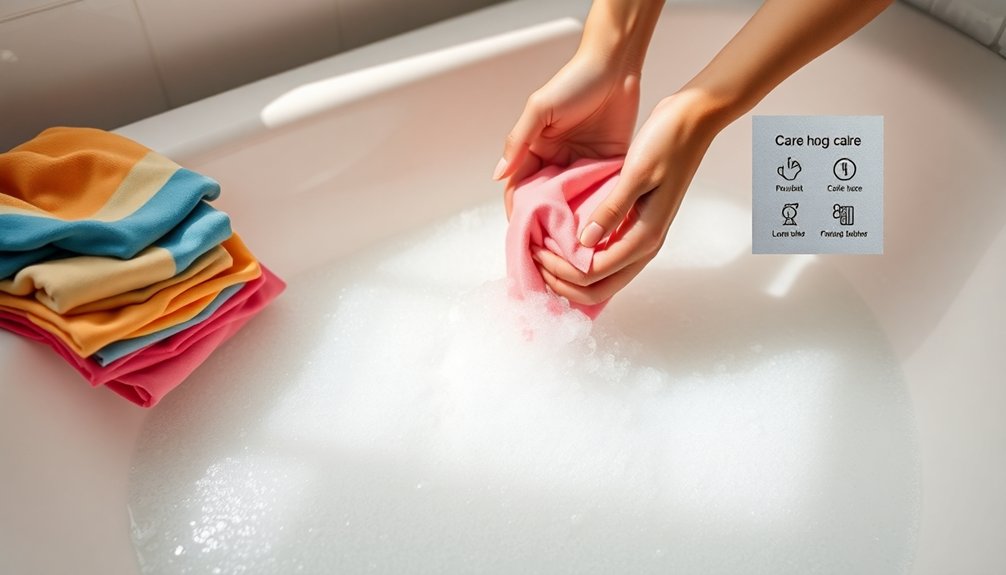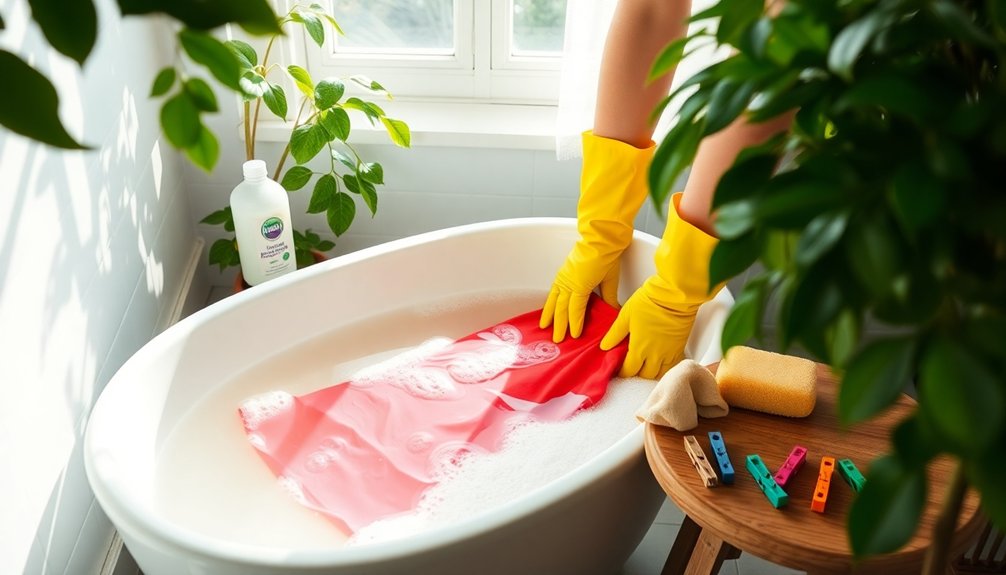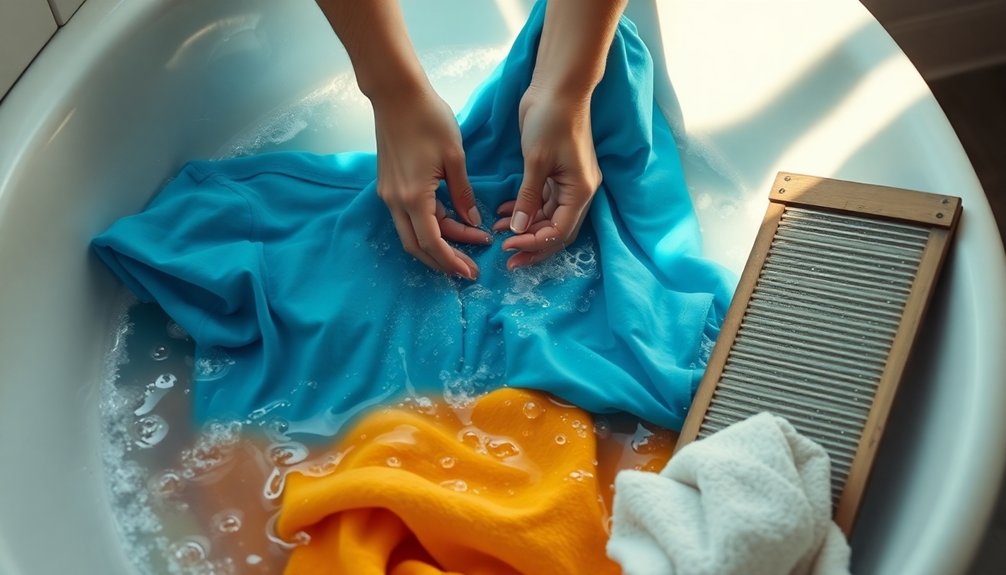To wash clothes in a bathtub, start by cleaning the tub thoroughly. Organize your clothes into piles: whites, colors, and darks. Check care labels and add 1 to 2 tablespoons of detergent to the warm water. Soak your clothes for 10 to 15 minutes, gently agitating them to loosen dirt. Rinse thoroughly, draining the soapy water and refilling the tub with clean water. Remove excess water, then choose an air drying method. Discover more tips to enhance your laundry process!
Clean the Bathtub
Before diving into the laundry process, it’s vital to prepare your bathtub properly. Start by removing all bottles and products from the tub’s edge. This guarantees you maintain hygiene and have ample space to work.
Next, grab an all-purpose cleaner and thoroughly clean the bathtub to eliminate any dirt and grime. This step is significant, as leftover cleaning product residue can damage your clothes during washing. Avoid cleaners with bleach, as they can harm your garments. Consider using a vinegar and water solution to effectively clean the tub without harsh chemicals.
Rinse the tub well with clean water to verify no soap or residue remains. A clean bathtub sets the stage for achieving better washing results and helps you effectively remove dirt from your clothes.
Now you’re ready to begin your laundry!
Organize Your Clothes
To get the best results when washing clothes in your bathtub, start by organizing your laundry into distinct categories. This step helps prevent color bleeding and guarantees effective cleaning.
For optimal cleaning in your bathtub, categorize your laundry to prevent color bleeding and ensure effective results.
Here’s how to sort your clothes:
- Gather all dirty laundry – Turn garments inside out to protect their surfaces during washing.
- Create three piles – Separate your clothes into whites, colors, and darks.
- Sort by fabric type – Wash similar types of clothing together; delicate items should never mix with heavier fabrics like towels.
- Limit your load size – For best results, stick to two pairs of jeans and two to three shirts, or one set of sheets. Additionally, maintaining an organized space with specialized storage solutions can further enhance the efficiency of your laundry routine.
Read the Labels

Before you start washing your clothes in the bathtub, you need to read the care labels carefully.
They provide important information about water temperature, fabric care, and whether items should be washed separately to avoid color bleeding.
Ignoring these instructions can lead to damaged garments, so make sure you know what’s safe to wash. Additionally, using non-toxic cleaners can help maintain the quality of your fabrics while being safe for your health.
Care Label Instructions
Understanding care label instructions is essential for ensuring your garments remain in good condition, especially when washing them in a bathtub.
Follow these steps to protect your clothes:
- Check for washing instructions: Look for specific water temperatures and methods recommended for delicate fabrics.
- Identify washing symbols: Determine if items can be machine washed, hand washed, or need dry cleaning.
- Assess colorfastness: Check if the fabric bleeds dye, which means washing it separately from other clothing.
- Note fabric content: Different materials have varying washing techniques and temperatures, so adhere to the label.
Color and Fabric Considerations
Reading the labels on your clothes is key to making informed decisions about washing, particularly when considering color and fabric.
Always check for specific washing instructions, including recommended water temperatures and whether the item should be hand-washed or dry cleaned.
Pay attention to color and fabric considerations; new colored garments may bleed dye, so wash them separately to avoid discoloration.
Delicate garments, like silk or lace, need cold water and gentle cleaning with appropriate laundry detergent, while sturdier fabrics can handle warmer temperatures.
Be cautious with heavy items such as towels or jeans, and don’t wash them with lightweight fabrics to prevent damage.
Following these guidelines guarantees your clothes stay vibrant and intact for longer.
Add Detergent to the Tub
Now that you’ve prepared your bathtub, it’s time to add detergent.
Choose a suitable laundry detergent and measure out 1 to 2 tablespoons to avoid residue on your clothes.
Mix the detergent into the water gently until it’s fully dissolved, ensuring an even cleaning solution for your garments. Additionally, consider using eco-friendly options like natural cleaners to promote a sustainable laundry routine.
Choosing the Right Detergent
Choosing the right detergent is essential for achieving clean, fresh-smelling clothes when washing them in a bathtub. Here are some tips to help you select the best detergent for your laundry needs:
- Quantity: Use 1 to 2 tablespoons of quality liquid laundry detergent to create an effective soapy solution without over-sudsing.
- Type of Fabric: Choose a detergent that suits the type of fabric you’re washing; gentle formulas work best for delicate items, while regular detergents are ideal for sturdier fabrics.
- Eco-Friendly Options: Opt for environmentally friendly and non-toxic detergents to minimize harmful chemical residues.
- Dissolving: Add the detergent while the tub is filling to guarantee it dissolves properly and mixes evenly in the water.
Proper Detergent Measurement
After selecting the right detergent for your laundry, it’s important to measure it properly to confirm ideal cleaning without waste.
For a moderate amount of clothing, use 1 to 2 tablespoons of liquid laundry detergent. This guarantees effective cleaning without overwhelming the water.
Always add the detergent while the water is running to help it dissolve and distribute evenly throughout the tub.
Remember, using too much detergent can leave residue on your clothes, requiring additional rinsing.
Also, pay attention to the water temperature; it should be appropriate for the type of fabric you’re washing. This affects how well the detergent works, especially when hand washing.
Stick to proper detergent measurement for the best results.
Mixing Detergent With Water
To effectively mix detergent with water in your bathtub, start by filling the tub with room-temperature water until it’s deep enough to fully submerge your clothes.
Avoid extreme temperatures to protect your fabrics.
Next, follow these steps:
- Add 1 to 2 teaspoons of liquid laundry detergent to the water.
- Stir the water gently with your hand or a stick to help dissolve the detergent evenly.
- Check the detergent’s instructions for specific mixing requirements.
- Opt for non-toxic or environmentally friendly options to protect sensitive skin.
Once you’ve created the soapy water, you can begin to add your clothes.
Remember to rub the clothes gently in the mixture to guarantee effective cleaning.
Soak the Clothes
Soaking your clothes in the bathtub is an essential step for effective cleaning, and it usually takes just 10 to 15 minutes.
Start by filling the tub with water at the appropriate temperature: warm for regular fabrics and cold for delicate items. Add 1 to 2 teaspoons of liquid laundry detergent, dispersing it evenly to create a soapy solution. Stir the water gently with your hands to guarantee the detergent fully dissolves.
Once the solution is ready, carefully immerse your clothes in the water. While they soak, agitate the clothes gently to enhance cleaning efficacy and help loosen any stubborn stains. Sorting clothes by fabric type can also improve the overall washing results.
After soaking, make sure to rinse it well to remove all detergent before moving to the next step.
Start Scrubbing

Now that your clothes have soaked in the soapy water, it’s time to start scrubbing for a thorough clean.
Follow these steps to make certain your clothes get the attention they need:
- Gently agitate the clothes by scrubbing them against each other.
- Focus on stained areas, using your hands to rub gently and work the soap into the fabric.
- Ascertain each piece of clothing gets an even scrub, paying extra attention to areas that tend to get dirtier.
- Continue scrubbing for about 5-10 minutes, allowing the soapy solution to penetrate the fabric. Remember, employing gentle blotting methods during this process can prevent fabric damage.
Once you’ve finished scrubbing, remember to rinse it well to remove all soap residue, ensuring your clothes feel fresh and clean.
Rinse the Clothes
After you’ve scrubbed your clothes, it’s important to rinse them thoroughly to remove any lingering soap residue.
Start by carefully draining the soapy water from the tub, guaranteeing the clothes stay in the tub to avoid losing them. Next, refill the tub with clean, cold water. This is essential for effectively rinsing the clothes.
Carefully drain the soapy water, ensuring the clothes remain in the tub, then refill with clean, cold water for effective rinsing.
Gently agitate them in the clean water, which helps to dislodge any remaining detergent. You might need to repeat this rinsing process two to three times to make sure all suds are eliminated. Additionally, regular vinegar cycles can help in maintaining a fresh and clean washer interior, which is crucial if you’re using your washer frequently.
Once you’re satisfied the clothes are rinsed properly, prepare to move on to the next step of removing excess water without wringing them out to prevent damage.
Remove Excess Water

Once you’ve rinsed your clothes, it’s essential to remove excess water to prevent damage and speed up the drying process. Here’s how to do it effectively:
- Gently squeeze the fabric between your hands to remove excess water, but don’t twist or wring to avoid damaging the fibers.
- Roll garments in a clean, dry towel if they’re still too wet. This helps absorb additional moisture before drying.
- Use a laundry basket or bucket to transport wet clothes to your drying area, ensuring they aren’t left sitting in water.
- Handle clothes promptly to avoid mildew and odors; aim to remove as much water as possible to expedite drying and protect the fabric. Regular maintenance of your washing routine can help prevent issues like mildew and odors.
Choose a Drying Method
After washing your clothes, it’s essential to choose the right drying method to preserve their quality.
You can opt for air drying on a clothesline, which is eco-friendly, or use indoor drying solutions like a drying rack if you’re short on space.
Always remember to check care labels for any specific drying instructions before you hang or toss your garments in the dryer. Additionally, consider the recommended frequency for changing bed linens to maintain hygiene and freshness in your home environment.
Air Drying Options
When you choose to air dry your clothes, you’re not just saving energy; you’re also preserving the quality of your fabrics.
Here are some effective air drying options:
- Drying Rack: Set up a drying rack in a well-ventilated area, away from direct sunlight to prevent fading.
- Clothesline: If you have outdoor space, hang your clothes on a clothesline, ensuring there’s enough space between items for airflow.
- Gently Squeeze: Before hanging, gently squeeze out excess water from garments to speed up the drying process, but avoid wringing.
- Ventilated Room: For indoor drying, choose a room near a window or with a fan to enhance airflow and reduce humidity.
Following these tips will help your clothes dry efficiently while maintaining their integrity.
Using a Clothesline
Using a clothesline is one of the most effective ways to dry your laundry while being kind to the environment.
To get started, set up your clothesline taut in an area with ample sunlight and airflow. This maximizes drying efficiency, making it easier to dry your clothes naturally.
When hanging your laundry, leave enough space between each garment to promote air circulation, which helps prevent musty odors. Use clothespins to securely fasten your clothes, ensuring they won’t blow away in the wind.
For the best results, hang items inside out to protect colors from fading due to prolonged sun exposure.
This eco-friendly method not only saves energy but also leaves your clothes smelling fresh.
Indoor Drying Solutions
If you find yourself with a load of laundry that needs drying but lack outdoor space, indoor drying solutions can save the day. Here are some practical methods to take into account:
- Use a drying rack: Position it near a window or heater to maximize airflow and reduce drying time.
- Create a makeshift clothesline: Stretch sturdy string or rope between two points, guaranteeing it can support wet clothes.
- Hang garments individually: Leave enough space between them to prevent moisture buildup and guarantee even drying.
- Utilize a fan: Circulate air around your drying area to speed up the process and prevent musty odors.
For delicate items, lay them flat on a towel, reshaping as needed to maintain their form.
Additional Tips for Bathtub Laundry
While washing clothes in a bathtub can be a convenient alternative, keeping a few additional tips in mind can enhance the process and ensure your garments stay in great shape.
Always check care labels to verify you can hand wash clothes and follow the recommended instructions. Use cold water and a gentle, eco-friendly detergent to protect both your fabrics and the environment.
Always read care labels to ensure hand washing is safe, and opt for cold water with eco-friendly detergent for best results.
For stubborn stains, consider using a soft-bristled brush during pre-treatment to avoid damaging the fabric. Rinse clothes thoroughly to eliminate all soap residues, which can irritate your skin or stiffen the fabric.
Finally, allow your clothes to air dry in a well-ventilated area to prevent musty odors and maintain their integrity. Additionally, ensure your bathtub is regularly disinfected to reduce the spread of harmful bacteria that could transfer to your laundry.
Happy washing!
Conclusion
Now that you’ve transformed your bathtub into a mini laundry oasis, you’ve taken the first step toward reclaiming your garments from the depths of dirt. Just like a phoenix rising from the ashes, your clothes will emerge fresh and rejuvenated. Embrace the simplicity of this method and remember that even the most mundane tasks can be moments of renewal. With these steps, you’re not just washing clothes; you’re breathing new life into your wardrobe, one soak at a time.